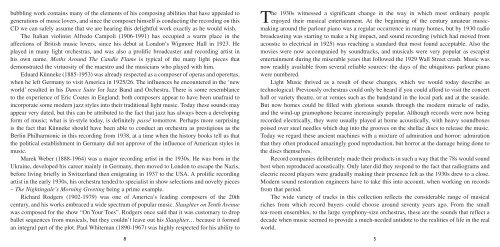GLCD5106 The 1930s.indd - The Classical Shop
GLCD5106 The 1930s.indd - The Classical Shop
GLCD5106 The 1930s.indd - The Classical Shop
Create successful ePaper yourself
Turn your PDF publications into a flip-book with our unique Google optimized e-Paper software.
ubbling work contains many of the elements of his composing abilities that have appealed to<br />
generations of music lovers, and since the composer himself is conducting the recording on this<br />
CD we can safely assume that we are hearing this delightful work exactly as he would wish.<br />
<strong>The</strong> Italian violinist Alfredo Campoli (1906-1991) has occupied a warm place in the<br />
affections of British music lovers, since his debut at London’s Wigmore Hall in 1923. He<br />
played in many light orchestras, and was also a prolific broadcaster and recording artist in<br />
his own name. Moths Around <strong>The</strong> Candle Flame is typical of the many light pieces that<br />
demonstrated the virtuosity of the maestro and the musicians who played with him.<br />
Eduard Künneke (1885-1953) was already respected as a composer of operas and operettas,<br />
when he left Germany to visit America in 1925/26. <strong>The</strong> influences he encountered in the ‘new<br />
world’ resulted in his Dance Suite for Jazz Band and Orchestra. <strong>The</strong>re is some resemblance<br />
to the experience of Eric Coates in England; both composers appear to have been unafraid to<br />
incorporate some modern jazz styles into their traditional light music. Today these sounds may<br />
appear very dated, but this can be attributed to the fact that jazz has always been a developing<br />
form of music; what is in-style today, is definitely passé tomorrow. Perhaps more surprising<br />
is the fact that Künneke should have been able to conduct an orchestra as prestigious as the<br />
Berlin Philharmonic in this recording from 1938, at a time when the history books tell us that<br />
the political establishment in Germany did not approve of the influence of American styles in<br />
music.<br />
Marek Weber (1888-1964) was a major recording artist in the <strong>1930s</strong>. He was born in the<br />
Ukraine, developed his career mainly in Germany, then moved to London to escape the Nazis,<br />
before living briefly in Switzerland then emigrating in 1937 to the USA. A prolific recording<br />
artist in the early <strong>1930s</strong>, his orchestra tended to specialist in show selections and novelty pieces<br />
– <strong>The</strong> Nightingale’s Morning Greeting being a prime example.<br />
Richard Rodgers (1902-1979) was one of America’s leading composers of the 20th<br />
century, and his works embraced a wide spectrum of popular music. Slaughter on Tenth Avenue<br />
was composed for the show “On Your Toes”. Rodgers once said that it was customary to drop<br />
ballet sequences from musicals, but they couldn’t leave out his Slaughter… because it formed<br />
an integral part of the plot. Paul Whiteman (1890-1967) was highly respected for his ability to<br />
8<br />
T he <strong>1930s</strong> witnessed a significant change in the way in which most ordinary people<br />
enjoyed their musical entertainment. At the beginning of the century amateur musicmaking<br />
around the parlour piano was a regular occurrence in many homes, but by 1930 radio<br />
broadcasting was starting to make a big impact, and sound recording (which had moved from<br />
acoustic to electrical in 1925) was reaching a standard that most found acceptable. Also the<br />
movies were now accompanied by soundtracks, and musicals were very popular as escapist<br />
entertainment during the miserable years that followed the 1929 Wall Street crash. Music was<br />
now readily available from several reliable sources: the days of the ubiquitous parlour piano<br />
were numbered.<br />
Light Music thrived as a result of these changes, which we would today describe as<br />
technological. Previously orchestras could only be heard if you could afford to visit the concert<br />
hall or variety theatre, or at venues such as the bandstand in the local park and at the seaside.<br />
But now homes could be filled with glorious sounds through the modern miracle of radio,<br />
and the wind-up gramophone became increasingly popular. Although records were now being<br />
recorded electrically, they were usually played at home acoustically, with heavy soundboxes<br />
poised over steel needles which dug into the grooves on the shellac discs to release the music.<br />
Today we regard these ancient machines with a mixture of admiration and horror: admiration<br />
that they often produced amazingly good reproduction, but horror at the damage being done to<br />
the discs themselves.<br />
Record companies deliberately made their products in such a way that the 78s would sound<br />
best when reproduced acoustically. Only later did they respond to the fact that radiograms and<br />
electric record players were gradually making their presence felt as the <strong>1930s</strong> drew to a close.<br />
Modern sound restoration engineers have to take this into account, when working on records<br />
from that period.<br />
<strong>The</strong> wide variety of tracks in this collection reflects the considerable range of musical<br />
riches from which record buyers could choose around seventy years ago. From the small<br />
tea-room ensembles, to the large symphony-size orchestras, these are the sounds that reflect a<br />
decade when music seemed to provide a much-needed antidote to the realities of life in the real<br />
world.<br />
5



